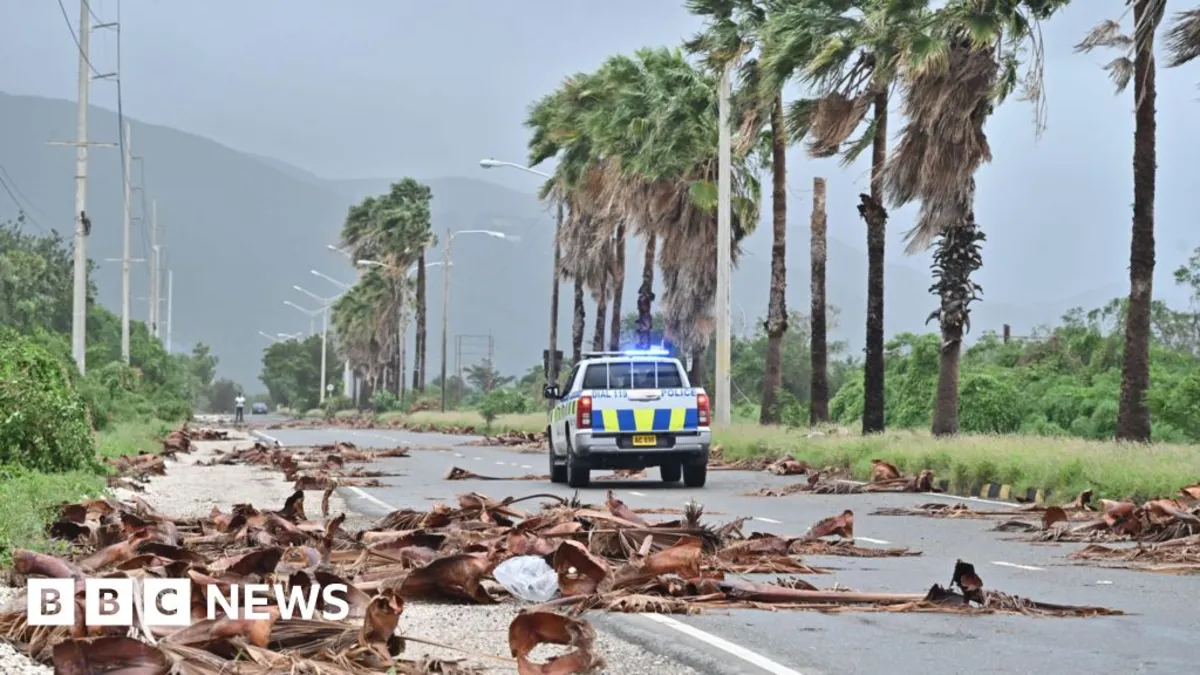
This morning, the usual sounds of life in Jamaica have been replaced by an eerie silence as many residents awaken to widespread destruction caused by Hurricane Melissa. Approximately three-quarters of the island is currently experiencing power outages, with significant portions of the western regions submerged under floodwaters. The hurricane's fierce winds and torrential rains have wreaked havoc, destroying homes and leaving communities devastated. One local official remarked that the destruction resembles scenes from an apocalyptic movie.
In response to the widespread damage, Prime Minister Andrew Holness officially declared Jamaica a disaster area late Tuesday. He warned of the hurricane's devastating impacts, which have significantly affected hospitals, homes, and businesses across the island. While no fatalities have been confirmed thus far, Montego Bay's mayor, Richard Vernon, expressed his immediate concern for residents’ safety, stating that his first task at daybreak would be to ensure that everyone is accounted for.
Hurricane Melissa has made its mark as the strongest storm to strike Jamaica in modern history. At its peak, the hurricane boasted sustained winds of 298 km/h (185 mph), surpassing the ferocity of Hurricane Katrina, which devastated New Orleans in 2005. Local journalist Kimone Francis described the night as one filled with relentless winds and heavy rain, noting the complete breakdown of communication networks, which has made it difficult to assess the full scale of the disaster.
Across Jamaica's central parishes, floodwaters have risen alarmingly, submerging the roofs of two-story homes. An anonymous resident shared her distress with the BBC, stating, “There is water coming in through the roof of my house. I am not okay.” Prime Minister Holness conveyed his fears of potential loss of life, indicating that the damage is extensive, affecting vital infrastructure such as hospitals, schools, and homes.
Local government minister Desmond Mckenzie reported that the southwestern parish of St Elizabeth is heavily flooded, with at least three families trapped in their homes in Black River. Rescue teams are facing significant challenges in reaching those in need due to the dangerous conditions, exacerbated by ongoing severe weather.
Verna Genus, a 73-year-old vegetable farmer from St Elizabeth, was sheltering in her home when the hurricane ripped the zinc roof off. She was with her sons and grandchild when the storm struck. Unable to communicate due to downed power lines, her sister in the UK, June Powell, described the harrowing moment when Verna realized her roof had disappeared. “She was wailing, ‘we are all finished,’” said June, who is anxiously awaiting restored communications.
Known as Jamaica's breadbasket, St Elizabeth produces a significant portion of the island's food supply. With crops submerged and fields destroyed, farmers face a dire financial recovery ahead. The north coast, particularly Montego Bay, a hub for tourism and home to the island's primary airport, will also take considerable time to recover. Mayor Vernon noted that floodwaters have effectively split the city in two, with roads inundated and access severely limited.
Reports from rural Jamaica reveal widespread fear and anxiety. Tamisha Lee, president of the Jamaica Network of Rural Women Producers, described the chaotic scene, stating, “Right now, what I’m seeing is heavy rain, powerful wind, and a lot of things flying all over the place.” The storm's rapid intensification, fueled by unusually warm Caribbean waters—an effect of climate change—has raised concerns about the increasing frequency of such severe weather events.
Thousands of tourists currently stranded on the island are grappling with fear and uncertainty. Pia Chevallier from Cambridge described the terrifying experience of the storm as her hotel room shook with the force of the winds. “The glass in the windows and patio doors was all vibrating,” she recounted. Another tourist, Wayne Gibson, shared that he and his family were sheltering in a communal hall, labeling their hotel a “disaster zone.”
As Hurricane Melissa moved on to make landfall in Cuba by early Wednesday, Jamaica remains paralyzed and silent. Although it has weakened to a Category 3 hurricane, it still possesses powerful winds exceeding 200 km/h (124 mph). Jamaica does have a catastrophe bond, a type of insurance designed to aid recovery efforts, but the immediate focus remains on the urgent needs of those affected by the disaster.